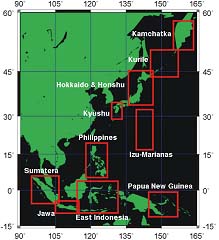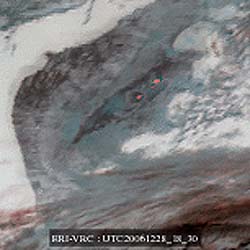Satellite Monitoring of Active Volcanoes in East Asia

Targeted Areas;
147 active volcanoes in East Asia are being monitored
by the MODIS and MTSAT-based system in near real- time.
The Earthquake Research Institute (ERI) of the University of Tokyo developed a near real-time monitoring system for 147 active volcanoes
in East Asia in cooperation with the Institute of Industrial Science (IIS) of the University of Tokyo and the University of London.
The system uses visible and infrared images from the US radiometer MODIS (Moderate Resolution Imaging Spectroradiometer) and
the Japanese satellite MTSAT (Multi-functional Transport Satellite) sensors on-boarded the Terra/Aqua series of polar orbiting satellites
and the MTSAT series geostationary satellites, respectively.
MODIS data being down-linked to the IIS of the University of Tokyo and also downloaded from NASA are used in this system.
Those of MTSAT are down-linked to the ERI of the University of Tokyo. The results and analyses of the MODIS infrared observations,
essentially thermal images and time-series radiance trends of each volcano targeted, are automatically uploaded on the Web site
(http://vrsserv.eri.u-tokyo.ac.jp/REALVOLC/).
As to MTSAT, both visible and infrared images are renewed every 60 minutes on the Web site immediately after reception,
which is useful for early detecting volcanic eruptions or change in activity style. In this way it is planned that volcanologists and
other interested parties may use the MODIS and MTSAT data as a broad check on the surface thermal state of the volcanoes they are
studying and may apply their own interpretations to any identified heating or cooling trend.
In the 2004-2005 eruption of Asama, they analyzed the activity using nighttime infrared data from MODIS in conjunction with
the data from ground-based instruments obtained simultaneously and chemical composition of the ejects, where they found
a close relationship between occurrence of thermally active period (pulse) and deep dyke intrusion. The observed period is divided into
four stages: S-I, S-II, S-III and S-IV, based on the relationship between thermal anomalies observed by MODIS and eruptive activity.
S-I (second half of August) is the thermally active period preceding the series of eruptions. This may have been caused by
a magma tic supply to the shallow level of the conduit, resulted from dyke intrusion at a deep level (1 km below sea level) in July,
as suggested by the ground deformation monitoring. This magma tic supply probably resulted in initiating the eruptive activity of S-II.
S-II (September 1 - mid-December) is the thermally active period during the series of eruptions, which is sub-divided into two stages:
S-IIa (September 1 - October 10) and S-IIb (October 10 - mid-December), by the two thermally active pulses in this period.
Similar pulses are also recognized in the time-series variation of eruptive amount of S-II, as well as the seism city and the SO2 discharge rate.
A deep dyke intrusion observed in the late S-IIa may have resulted in a new supply of magma to a shallow level, which caused the IIb activity.
After two months of inactive period of S-III (late December 2004 - February 2005), S-IV (March - at least April 2005),
the post-eruptive thermally active period started. Although this stage did not involve eruptive activities, SO2 discharge rate,
level of volcanic glow and height of plume raised. This may have been caused by the third magma tic supply to the shallow level in late January.
Dr. Takayuki Kaneko, the Research Assistant of ERI of University of Tokyo, said "MODIS is good for observing a small-scale eruption.
MTSAT is good for observing a large-scale eruption. We will continuously research the character of each volcano in detail and we hope to
contribute to the volcanic disaster-prevention in Asia."

Satellite Dish for MTSAT

Eruptions of two Volcanos at Polustrov Kamchatka. (MTSAT)